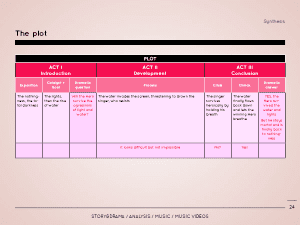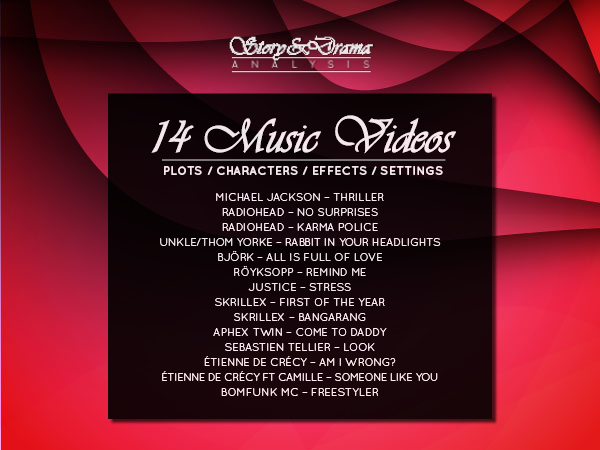This script analysis of the music video of the song No surprises by Radiohead is an abstract from our tutorial e-book 14 music videos.
Radiohead – No Surprises – Music video script analysis
The video tells the story of the singer who is drowning himself in a jar and ressurecting.
- Music video director: Grant Gee
Radiohead No Surprises music video analysis
00:00 Black screen. A few small orange or red lights appear and disappear on the very first notes of the song.
Exposition of the story’s world: we start in nothingness.
Media effect: the synchronization of the two media – video and music – instills an impression of harmony.
Structure: catalyst – first appearance of this abstract and metaphorical element: lights, whose shapes and colors will diversify.
00:08 A weak neon light lets us discern the features of a face.
This face is obviously the character who will become the Hero of the plot.
00:14 We are now able to recognize Radiohead’s singer, Thom Yorke. His face appears and disappears on the blinking rhythm of the colored lights and neon lights.
This blinking is part of the catalyst, divided into several steps: the existence of the Hero is threatened by the uncertainty of the issue of the symbolic fight between, on one side, nothingness, darkness, existence, disparition, and on the other side, being, lightness, presence, apparition.
00:23 Thom Yorke takes glances all around him. A white on black text, being written on mirror from the right to the left, starts scrolling from the bottom to the top: it is the lyrics of the song.
The glances of Thom Yorke play the role of identificatory signal: before, he was watching us, establishing close and privileged eye-contact, and now, since he is reading a text we cannot easily read, we are invited to privilege his point of view, which strengthens the identification process from the viewer to the Hero.
00:26 Thom Yorke starts singing in sync with the music. His face fills the screen.
Media effect: the synchronization between the three media – the video, the written text, and the music (itself a mix of the sung (written) lyrics and instrumental melodies) creates an impression of fascinating harmony.
00:33 For ten seconds, a range of new neons light up and place their reflection on the singer’s features. A bigger neon underlines his left eyebrow, illuminating his pale and gloomy face.
Those apparitions of light are a threat over the Hero; they can blind him as a desk lamp would a convict during a police questioning.
Intertextuality: this blinding pale light alludes to other elements in the very rich audiovisual universe of Radiohead’s music videos. For example in the title of the song Rabbit in Your Headlights or in the video of Karma Police, in which a persecuted man is captured in the headlights of a car.
The lyrics are still scrolling, line by line, in sync with the music, the singer’s lips singing and the diodes turning on and off.
Pattern repetition develops the video as a fight between nothingness and being, light and darkness, silence and music.
01:19 On a more intense music moment, a new, bigger neon light appears on the singer’s right cheek.
This event looks like an attack – clearer, franker than the previous one – of the light against the singer; thus this light takes the confirmed role of Antagonist.
01:21 A wall of pale blue neons light up at the extreme right of the screen. Just after, a level of water starts rising from the bottom of the screen.
Structure: new catalyst element which installs a second Antagonist more powerful than the first, leads us to partially rebuild the characters’ table. The level of rising water will be the main Antagonist and the lights will be the Antagonist’s Helpers. This material antagonism has no proper goal or even any will, but it has a very direct effect over the Hero: the lights blind him and stop him from seeing or looking, while the rising water level stops him from breathing and singing.
Dramatic question: Will the Hero get out alive? Will he be able to see, breathe and sing?
01:40 The water level reaches the singer’s mouth, in the middle of the “No alarms and no surprises” chorus. He adapts by lifting his chin up to finish singing the chorus, but not the last verse. He then closes his eyes, avoids the water by lifting his face up for as long as he can, breathes strongly in, then dives his head into the water which is invading his vital space.
The conflict situation between the singer and the water becomes obvious. (By the way, in case you’re interested in this kind of low-budget but still speactular and intense movies, you might like to read this article: Six tips to making a no-budget music video.)
Structure: this water rise puts an end to the catalyst (divided into several micro-steps), and implicitly repeats the dramatic question: “Will the Hero survive or be drown?” and thus logically ends Act I of this unique plot.
02:00 The water now reaches half of the screen and produces a magnifying glass effect on Thom Yorke’s face. He breathes out a bit of air through his nose. The water level rises more. Thom Yorke opens his eyes and watches – his left eye stays half closed. Since he is in the water, he does not sing any more, even if the song goes on without him: the text scrolls, the lights blink, the second chorus ends.
Act II, a series of attacks/defenses. The conflict seems to be in favor of the Antagonist – lights blind the singer, water stops him from singing and breathing – but the fact that the song continues, shows that the singer’s side is strong. He is able to sing without singing which regulates the forces balance and gives some hope back to the Hero, thus to the audience.
02:35 An instrumental plays while the screen gets filled with the singer’s submerged head.
Even if nothing really happens, the picture is fascinating and scary and the dramatic tension is strong, because the seconds pass and the audience knows very well that nobody can hold one’s breathing for longer than around one minute, on average.
The identification of the audience to the character works fully: we’re dying with him, a world-class star is in danger of imminent drowning, right now, under our watch!
02:52 The singer’s eyes blink, we feel he is getting closer to his vital limit.
Structure: this scene is the crisis, the strongest moment of Act III. During those twenty unsustainable seconds, the Antagonist seems to be on the point of winning, because the Hero’s death now is just a matter of seconds away. Happily, he uses his main quality: resistance to oppression, and more precisely, to asphyxiation.
The identification process strikes again: it is very difficult not to feel a strong anguish coming from the automatic and intuitive empathy we can feel towards the Hero’s own anguish.
02:56 He closes his eyes. The level of water starts going down. The singer lifts his face up to take a huge breath in. We can see and feel his pain through his grimacing wet face. He swallows two times, his expression changes and he starts singing again, in sync, loud and rageously, staring at us: “No alarms and no surprises”.
Structure: climax, this decisive moment gives us the result of the conflict intensified by the crisis and answers the dramatic question: the Hero finally triumphs. With a remarkable irony, the sync between his recovery and the lyrics “No alarms and no surprises” shows that the Hero was able to retrieve his calm and his fearlessness which characterized him since the beginning – outside of the critical moment when his eyes blinked because he was going to die.
03:06 The wall of pale blue neons turns off.
03:14 The big white neon turns off. Thom Yorke’s face comes back to darkness.
03:16 The eyebrow neon turns off, then the range of neons. The other lights and neons are still blinking.
03:28 All the neons turn off except one.
03:36 Only one neon and a few lights still allow the viewer to see the singer’s features; he closes his eyes, peacefully.
03:40 Thom Yorke’s face blinks in red tones, then disappears. The last lights blink on the last music notes.
03:46 Back to total black screen.
03:57 End of music.
This series of light then sound extinctions end Act III and finish answering the two dramatic questions asked in Act I:
- YES, the Hero could survive the rise of water – a metaphor of the proofs and the difficulties of existence?
- But NO, he is not able to escape the final state of any living being, even a Hero: coming back to nothingness.


Comment
The proof of the Hero
In spite of its extreme simplicity – only one plot, only one human character, one scene, a minimum of shots and camera moves – this video works.
How can it have such a strong impact over the viewer? To explain its expressive power, we have to dive into the symbolical depths of the human mind.
This video does not actually tell us what it appears to show. It is not about the head of a guy in an aquarium – a boring theme. It is about the archetype of the Hero, the human being, fighting with the proofs of life. His main goal, as is ours (as the viewers), consists in surviving.
The human being meets very ambivalent elements on his road:
- nothingness, darkness, but also light,
- water – water of the ocean where life was born, liquid of the utero in which we all grew, vital water which can also drown and kill,
- and air – air we need to breathe and stay alive – the most primary need of all, and whose lack creates asphyxiation, air we need to speak and sing; that is to exist as social human beings.
The Hero, without having anything special to do, is condemned to stay there and to be alive in a passive way:
- coming out from nothingness, caused by light (the diodes turn on by themselves, he does not control them, but they control his visibility), blinded by these same diodes, then coming back to nothingness, due to darkness (the diodes turn off also by themselves),
- breathing and singing because it is in his nature, then stopped from breathing and singing because the water is rising (perhaps alluding to the current ecological global crisis – ice is melting and oceans are rising), then finding back his skills when water flows back.
This tension between a young, rich, and famous singer and the primary, universal needs for air, safety, comfort, makes all the dramatic tension and the impact of the video, allegory of the human life always on the edge of death, but allowing us to survive threats for a while, even if in the end we all go back to nothingness.
…
Do you want to learn to write a music video script?
Then read our e-book: 14 Music Videos.
